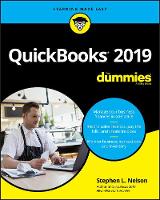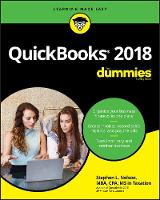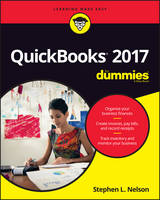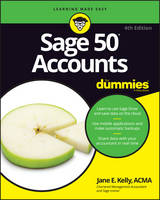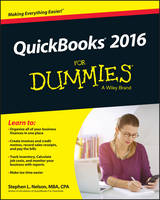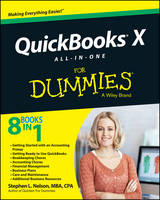QuickBooks 2018 All-in-One For Dummies
QuickBooks 2018 All-in-One For Dummies
Nelson, Stephen L.
John Wiley & Sons Inc
01/2018
656
Mole
Inglês
9781119397366
832
Descrição não disponível.
Introduction 1 About This Book 1 Foolish Assumptions 2 Icons Used in This Book 3 Beyond the Book 3 Where to Go from Here 3 Book 1: An Accounting Primer 5 Chapter 1: Principles of Accounting 7 The Purpose of Accounting 7 Reviewing the Common Financial Statements 10 The Philosophy of Accounting 23 A Few Words about Tax Accounting 26 Chapter 2: Double-Entry Bookkeeping 27 The Fiddle-Faddle Method of Accounting 28 How Double-Entry Bookkeeping Works 30 Almost a Real-Life Example 36 A Few Words about How QuickBooks Works 44 Chapter 3: Special Accounting Problems 47 Working with Accounts Receivable 48 Recording Accounts Payable Transactions 51 Inventory Accounting 53 Accounting for Fixed Assets 57 Recognizing Liabilities 61 Closing Out Revenue and Expense Accounts 65 One More Thing 68 Book 2: Getting Ready to Use QuickBooks 69 Chapter 1: Setting Up QuickBooks 71 Planning Your New QuickBooks System 71 Installing QuickBooks 74 Dealing with the Presetup Jitters 75 Running the QuickBooks Setup Wizard 77 Identifying the Starting Trial Balance 85 Chapter 2: Loading the Master File Lists 91 Setting Up the Chart of Accounts List 92 Setting Up the Item List 97 Working with the Price Level List 97 Using Sales Tax Codes 98 Setting Up a Payroll Item List 98 Setting Up Classes 99 Setting Up a Customer List 101 Setting Up the Vendor List 106 Setting Up a Fixed Assets List 109 Setting Up a Price Level List 110 Setting Up a Billing Rate Level List 111 Setting Up Your Employees 111 Setting Up an Other Names List 111 Setting Up the Profile Lists 112 Chapter 3: Fine-Tuning QuickBooks 115 Accessing the Preferences Settings 116 Setting the Accounting Preferences 118 Setting the Bills Preferences 121 Setting the Calendar Preferences 121 Setting the Checking Preferences 121 Changing the Desktop View 123 Setting Finance Charge Calculation Rules 126 Setting General Preferences 126 Controlling Integrated Applications 128 Controlling Inventory 129 Controlling How Jobs and Estimates Work 130 Dealing with Multiple Currencies 132 Starting Integrated Payment Processing 132 Controlling How Payroll Works 133 Telling QuickBooks How Reminders Should Work 135 Specifying Reports & Graphs Preferences 136 Setting Sales & Customers Preferences 140 Specifying How Sales Are Taxed 141 Setting the Search Preferences 142 Setting the Send Forms Preferences 143 Fine-Tuning the Service Connection 144 Controlling Spell Checking 145 Controlling How 1099 Tax Reporting Works 146 Setting Time & Expenses Preferences 146 Book 3: Bookkeeping Chores 149 Chapter 1: Invoicing Customers 151 Choosing an Invoice Form 151 Customizing an Invoice Form 152 Invoicing a Customer 162 Billing for Time 168 Printing Invoices 173 Emailing Invoices 173 Recording Sales Receipts 174 Recording Credit Memos 177 Receiving Customer Payments 179 Assessing Finance Charges 181 Using Odds and Ends on the Customers Menu 183 Chapter 2: Paying Vendors 185 Creating a Purchase Order 185 Recording the Receipt of Items 189 Simultaneously Recording the Receipt and the Bill 192 Entering a Bill 194 Paying Bills 198 Reviewing the Other Vendor Menu Commands 201 Chapter 3: Tracking Inventory and Items 205 Looking at Your Item List 206 Adding Items to the Item List 208 Editing Items 223 Adjusting Physical Counts and Inventory Values 224 Adjusting Prices and Price Levels 227 Managing Inventory in a Manufacturing Firm 231 Chapter 4: Managing Cash and Bank Accounts 237 Writing Checks 238 Making Bank Deposits 246 Transferring Money between Bank Accounts 249 Working with the Register 251 Using Edit Menu Commands 258 Reconciling the Bank Account 262 Reviewing the Other Banking Commands 266 Chapter 5: Paying Employees 269 Setting Up Basic Payroll 269 Scheduling Payroll Runs 276 Paying Employees 276 Editing and Voiding Paychecks 278 Paying Payroll Liabilities 279 Book 4: Accounting Chores 281 Chapter 1: For Accountants Only 283 Working with QuickBooks Journal Entries 283 Updating Company Information 286 Working with Memorized Transactions 286 Reviewing the Accountant & Taxes Reports 287 Creating an Accountant's Copy of the QuickBooks Data File 289 Using the Client Data Review Commands 297 Chapter 2: Preparing Financial Statements and Reports 299 Some Wise Words Up Front 299 Producing a Report 300 Working with the Report Window 301 Modifying a Report 311 Processing Multiple Reports 319 A Few Words about Document Retention 320 Chapter 3: Preparing a Budget 323 Reviewing Common Budgeting Tactics 323 Taking a Practical Approach to Budgeting 327 Using the Set Up Budgets Window 327 Managing with a Budget 332 Some Wrap-Up Comments on Budgeting 334 Chapter 4: Using Activity-Based Costing 337 Reviewing Traditional Overhead Allocation 338 Understanding How ABC Works 340 Implementing a Simple ABC System 345 Seeing How QuickBooks Supports ABC 346 Turning On Class Tracking 347 Using Classes for ABC 348 Chapter 5: Setting Up Project and Job Costing Systems 353 Setting Up a QuickBooks Job 353 Tracking Job or Project Costs 356 Job Cost Reporting 359 Using Job Estimates 360 Progress Billing 362 Book 5: Financial Management 365 Chapter 1: Ratio Analysis 367 Some Caveats about Ratio Analysis 368 Liquidity Ratios 369 Leverage Ratios 371 Activity Ratios 375 Profitability Ratios 379 Chapter 2: Economic Value Added Analysis 385 Introducing the Logic of EVA 385 Seeing EVA in Action 386 Reviewing Some Important Points about EVA 389 Using EVA When Your Business Has Debt 391 Presenting Two Final Pointers 395 And Now, a Word to My Critics 396 Chapter 3: Capital Budgeting in a Nutshell 399 Introducing the Theory of Capital Budgeting 399 Calculating the Rate of Return on Capital 402 Measuring Liquidity 412 Thinking about Risk 412 What Does All of This Have to Do with QuickBooks? 414 Book 6: Business Plans 415 Chapter 1: Profit-Volume-Cost Analysis 417 Seeing How Profit-Volume-Cost Analysis Works 418 Calculating Break-Even Points 420 Using Real QuickBooks Data for Profit-Volume-Cost Analysis 422 Recognizing the Downside of the Profit-Volume-Cost Model 424 Using the Profit-Volume-Cost Analysis Workbook 426 Chapter 2: Creating a Business Plan Forecast 437 Reviewing Financial Statements and Ratios 438 Using the Business Plan Workbook 439 Understanding the Workbook Calculations 446 Customizing the Starter Workbook 472 Chapter 3: Writing a Business Plan 475 What the Term "Business Plan" Means 475 A Few Words about Strategic Plans 476 Look, Ma: No Strategy 478 A White-Paper Business Plan 480 A New-Venture Plan 483 Book 7: Care and Maintenance 489 Chapter 1: Administering QuickBooks 491 Keeping Your Data Confidential 491 Using QuickBooks in a Multiuser Environment 493 Using Audit Trails 503 Enabling Simultaneous Multiuser Access 504 Maintaining Good Accounting Controls 505 Chapter 2: Protecting Your Data 509 Backing Up the QuickBooks Data File 509 Restoring a QuickBooks Data File 515 Condensing the QuickBooks Company Files 520 Chapter 3: Troubleshooting 529 Using the QuickBooks Help File and This Book 529 Browsing Intuit's Product-Support Website 531 Checking Another Vendor's Product-Support Website 533 Tapping into Intuit's Online and Expert Communities 533 When All Else Fails 534 Book 8: Appendixes 535 Appendix A: A Crash Course in Excel 537 Starting Excel 537 Stopping Excel 538 Explaining Excel's Workbooks 538 Putting Text, Numbers, and Formulas in Cells 539 Writing Formulas 540 Scrolling through Big Workbooks 541 Copying and Cutting Cell Contents 542 Formatting Cell Contents 544 Recognizing That Functions Are Simply Formulas 546 Saving and Opening Workbooks 549 Printing Excel Workbooks 551 One Other Thing to Know 552 Appendix B: Government Web Resources for Businesses 553 Bureau of Economic Analysis 553 Bureau of Labor Statistics 556 Census Bureau 560 Securities and Exchange Commission 563 Federal Reserve 565 Government Printing Office 567 Internal Revenue Service 569 Appendix C: Glossary of Accounting and Financial Terms 571 Index 599
Este título pertence ao(s) assunto(s) indicados(s). Para ver outros títulos clique no assunto desejado.
QuickBooks; QuickBooks 2018; latest version of QuickBooks; small business; small business finance; small business finances; using QuickBooks; using QuickBooks at work; how to use QuickBooks; small business accounting; QuickBooks 2018 All-in-One For Dummies; Stephen L. Nelson
Introduction 1 About This Book 1 Foolish Assumptions 2 Icons Used in This Book 3 Beyond the Book 3 Where to Go from Here 3 Book 1: An Accounting Primer 5 Chapter 1: Principles of Accounting 7 The Purpose of Accounting 7 Reviewing the Common Financial Statements 10 The Philosophy of Accounting 23 A Few Words about Tax Accounting 26 Chapter 2: Double-Entry Bookkeeping 27 The Fiddle-Faddle Method of Accounting 28 How Double-Entry Bookkeeping Works 30 Almost a Real-Life Example 36 A Few Words about How QuickBooks Works 44 Chapter 3: Special Accounting Problems 47 Working with Accounts Receivable 48 Recording Accounts Payable Transactions 51 Inventory Accounting 53 Accounting for Fixed Assets 57 Recognizing Liabilities 61 Closing Out Revenue and Expense Accounts 65 One More Thing 68 Book 2: Getting Ready to Use QuickBooks 69 Chapter 1: Setting Up QuickBooks 71 Planning Your New QuickBooks System 71 Installing QuickBooks 74 Dealing with the Presetup Jitters 75 Running the QuickBooks Setup Wizard 77 Identifying the Starting Trial Balance 85 Chapter 2: Loading the Master File Lists 91 Setting Up the Chart of Accounts List 92 Setting Up the Item List 97 Working with the Price Level List 97 Using Sales Tax Codes 98 Setting Up a Payroll Item List 98 Setting Up Classes 99 Setting Up a Customer List 101 Setting Up the Vendor List 106 Setting Up a Fixed Assets List 109 Setting Up a Price Level List 110 Setting Up a Billing Rate Level List 111 Setting Up Your Employees 111 Setting Up an Other Names List 111 Setting Up the Profile Lists 112 Chapter 3: Fine-Tuning QuickBooks 115 Accessing the Preferences Settings 116 Setting the Accounting Preferences 118 Setting the Bills Preferences 121 Setting the Calendar Preferences 121 Setting the Checking Preferences 121 Changing the Desktop View 123 Setting Finance Charge Calculation Rules 126 Setting General Preferences 126 Controlling Integrated Applications 128 Controlling Inventory 129 Controlling How Jobs and Estimates Work 130 Dealing with Multiple Currencies 132 Starting Integrated Payment Processing 132 Controlling How Payroll Works 133 Telling QuickBooks How Reminders Should Work 135 Specifying Reports & Graphs Preferences 136 Setting Sales & Customers Preferences 140 Specifying How Sales Are Taxed 141 Setting the Search Preferences 142 Setting the Send Forms Preferences 143 Fine-Tuning the Service Connection 144 Controlling Spell Checking 145 Controlling How 1099 Tax Reporting Works 146 Setting Time & Expenses Preferences 146 Book 3: Bookkeeping Chores 149 Chapter 1: Invoicing Customers 151 Choosing an Invoice Form 151 Customizing an Invoice Form 152 Invoicing a Customer 162 Billing for Time 168 Printing Invoices 173 Emailing Invoices 173 Recording Sales Receipts 174 Recording Credit Memos 177 Receiving Customer Payments 179 Assessing Finance Charges 181 Using Odds and Ends on the Customers Menu 183 Chapter 2: Paying Vendors 185 Creating a Purchase Order 185 Recording the Receipt of Items 189 Simultaneously Recording the Receipt and the Bill 192 Entering a Bill 194 Paying Bills 198 Reviewing the Other Vendor Menu Commands 201 Chapter 3: Tracking Inventory and Items 205 Looking at Your Item List 206 Adding Items to the Item List 208 Editing Items 223 Adjusting Physical Counts and Inventory Values 224 Adjusting Prices and Price Levels 227 Managing Inventory in a Manufacturing Firm 231 Chapter 4: Managing Cash and Bank Accounts 237 Writing Checks 238 Making Bank Deposits 246 Transferring Money between Bank Accounts 249 Working with the Register 251 Using Edit Menu Commands 258 Reconciling the Bank Account 262 Reviewing the Other Banking Commands 266 Chapter 5: Paying Employees 269 Setting Up Basic Payroll 269 Scheduling Payroll Runs 276 Paying Employees 276 Editing and Voiding Paychecks 278 Paying Payroll Liabilities 279 Book 4: Accounting Chores 281 Chapter 1: For Accountants Only 283 Working with QuickBooks Journal Entries 283 Updating Company Information 286 Working with Memorized Transactions 286 Reviewing the Accountant & Taxes Reports 287 Creating an Accountant's Copy of the QuickBooks Data File 289 Using the Client Data Review Commands 297 Chapter 2: Preparing Financial Statements and Reports 299 Some Wise Words Up Front 299 Producing a Report 300 Working with the Report Window 301 Modifying a Report 311 Processing Multiple Reports 319 A Few Words about Document Retention 320 Chapter 3: Preparing a Budget 323 Reviewing Common Budgeting Tactics 323 Taking a Practical Approach to Budgeting 327 Using the Set Up Budgets Window 327 Managing with a Budget 332 Some Wrap-Up Comments on Budgeting 334 Chapter 4: Using Activity-Based Costing 337 Reviewing Traditional Overhead Allocation 338 Understanding How ABC Works 340 Implementing a Simple ABC System 345 Seeing How QuickBooks Supports ABC 346 Turning On Class Tracking 347 Using Classes for ABC 348 Chapter 5: Setting Up Project and Job Costing Systems 353 Setting Up a QuickBooks Job 353 Tracking Job or Project Costs 356 Job Cost Reporting 359 Using Job Estimates 360 Progress Billing 362 Book 5: Financial Management 365 Chapter 1: Ratio Analysis 367 Some Caveats about Ratio Analysis 368 Liquidity Ratios 369 Leverage Ratios 371 Activity Ratios 375 Profitability Ratios 379 Chapter 2: Economic Value Added Analysis 385 Introducing the Logic of EVA 385 Seeing EVA in Action 386 Reviewing Some Important Points about EVA 389 Using EVA When Your Business Has Debt 391 Presenting Two Final Pointers 395 And Now, a Word to My Critics 396 Chapter 3: Capital Budgeting in a Nutshell 399 Introducing the Theory of Capital Budgeting 399 Calculating the Rate of Return on Capital 402 Measuring Liquidity 412 Thinking about Risk 412 What Does All of This Have to Do with QuickBooks? 414 Book 6: Business Plans 415 Chapter 1: Profit-Volume-Cost Analysis 417 Seeing How Profit-Volume-Cost Analysis Works 418 Calculating Break-Even Points 420 Using Real QuickBooks Data for Profit-Volume-Cost Analysis 422 Recognizing the Downside of the Profit-Volume-Cost Model 424 Using the Profit-Volume-Cost Analysis Workbook 426 Chapter 2: Creating a Business Plan Forecast 437 Reviewing Financial Statements and Ratios 438 Using the Business Plan Workbook 439 Understanding the Workbook Calculations 446 Customizing the Starter Workbook 472 Chapter 3: Writing a Business Plan 475 What the Term "Business Plan" Means 475 A Few Words about Strategic Plans 476 Look, Ma: No Strategy 478 A White-Paper Business Plan 480 A New-Venture Plan 483 Book 7: Care and Maintenance 489 Chapter 1: Administering QuickBooks 491 Keeping Your Data Confidential 491 Using QuickBooks in a Multiuser Environment 493 Using Audit Trails 503 Enabling Simultaneous Multiuser Access 504 Maintaining Good Accounting Controls 505 Chapter 2: Protecting Your Data 509 Backing Up the QuickBooks Data File 509 Restoring a QuickBooks Data File 515 Condensing the QuickBooks Company Files 520 Chapter 3: Troubleshooting 529 Using the QuickBooks Help File and This Book 529 Browsing Intuit's Product-Support Website 531 Checking Another Vendor's Product-Support Website 533 Tapping into Intuit's Online and Expert Communities 533 When All Else Fails 534 Book 8: Appendixes 535 Appendix A: A Crash Course in Excel 537 Starting Excel 537 Stopping Excel 538 Explaining Excel's Workbooks 538 Putting Text, Numbers, and Formulas in Cells 539 Writing Formulas 540 Scrolling through Big Workbooks 541 Copying and Cutting Cell Contents 542 Formatting Cell Contents 544 Recognizing That Functions Are Simply Formulas 546 Saving and Opening Workbooks 549 Printing Excel Workbooks 551 One Other Thing to Know 552 Appendix B: Government Web Resources for Businesses 553 Bureau of Economic Analysis 553 Bureau of Labor Statistics 556 Census Bureau 560 Securities and Exchange Commission 563 Federal Reserve 565 Government Printing Office 567 Internal Revenue Service 569 Appendix C: Glossary of Accounting and Financial Terms 571 Index 599
Este título pertence ao(s) assunto(s) indicados(s). Para ver outros títulos clique no assunto desejado.




